HONDA ACCORD SEDAN 2001 Owner's Manual (in English)
Manufacturer: HONDA, Model Year: 2001, Model line: ACCORD SEDAN, Model: HONDA ACCORD SEDAN 2001Pages: 372, PDF Size: 6.1 MB
Page 301 of 372
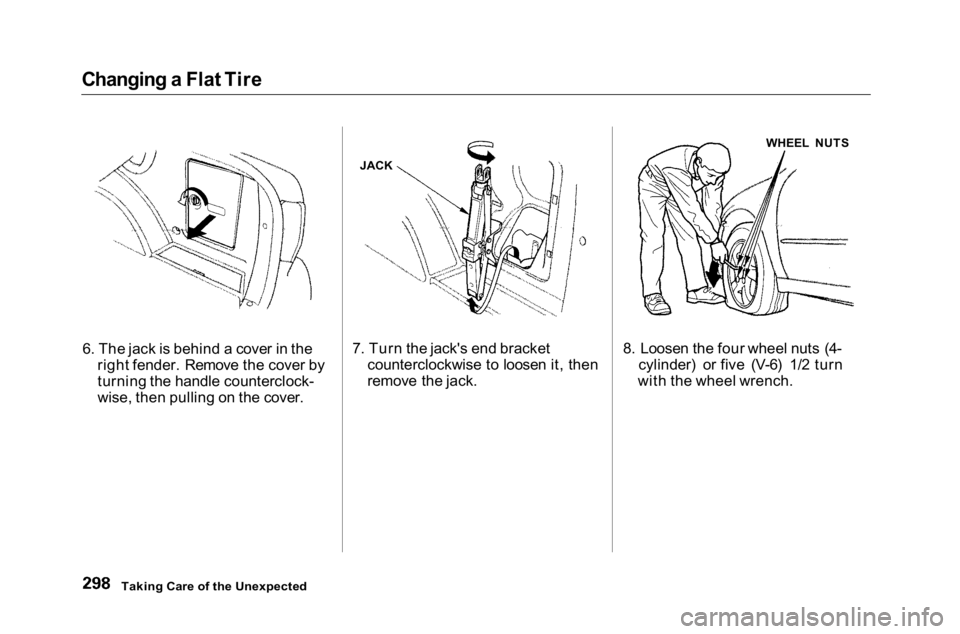
Changing a Flat Tire
6. The jack is behind a cover in the right fender. Remove the cover by
turning the handle counterclock-
wise, then pulling on the cover. 7. Turn the jack's end bracket
counterclockwise to loosen it, then
remove the jack. 8. Loosen the four wheel nuts (4-
cylinder) or five (V-6) 1/2 turn
with the wheel wrench.
Taking Care of the Unexpected
JACK
WHEEL NUTS
Page 302 of 372
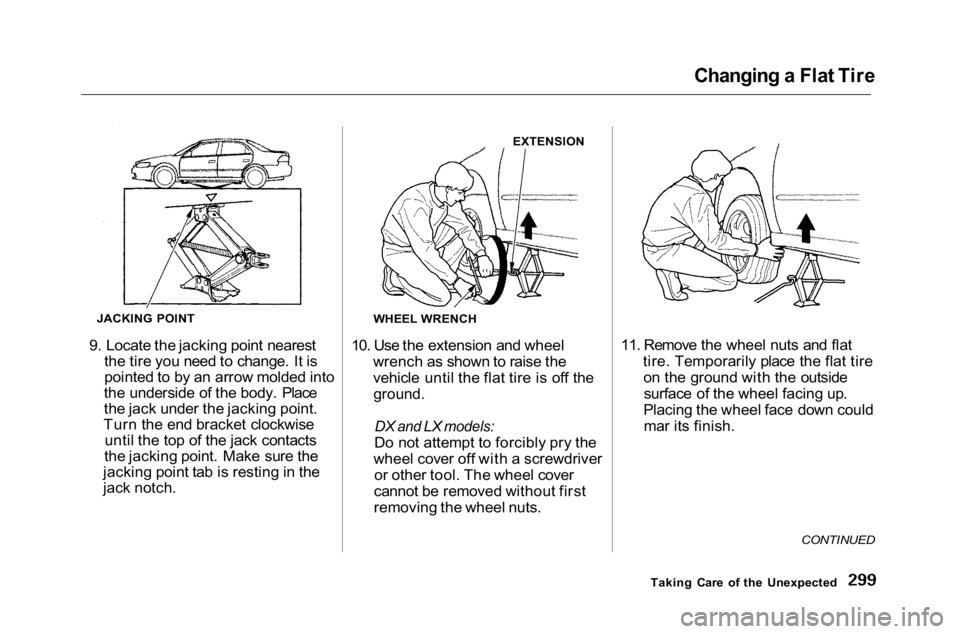
Changing a Flat Tire
9. Locate the jacking point nearest the tire you need to change. It is
pointed to by an arrow molded into
the underside of the body. Place
the jack under the jacking point.
Turn the end bracket clockwise until the top of the jack contacts
the jacking point. Make sure the
jacking point tab is resting in the
jack notch. 10. Use the extension and wheel
wrench as shown to raise the
vehicle until the flat tire is off the
ground.
DX and LX models:
Do not attempt to forcibly pry the
wheel cover off with a screwdriver or other tool. The wheel cover
cannot be removed without first
removing the wheel nuts. 11. Remove the wheel nuts and flat
tire. Temporarily place the flat tireon the ground with the outsidesurface of the wheel facing up.
Placing the wheel face down could mar its finish.
CONTINUED
Taking Care of the Unexpected
JACKING POINT
EXTENSION
WHEEL WRENCH
Page 303 of 372
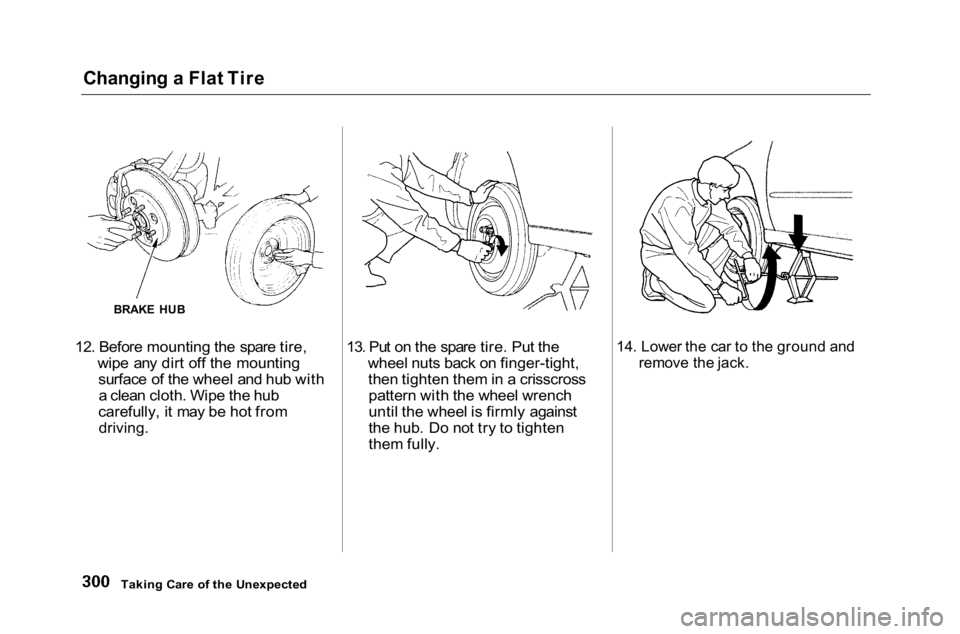
Changing a Flat Tire
12. Before mounting the spare tire, wipe any dirt off the mountingsurface of the wheel and hub witha clean cloth. Wipe the hub
carefully, it may be hot from
driving.
13. Put on the spare tire. Put the
wheel nuts back on finger-tight,then tighten them in a crisscrosspattern with the wheel wrench
until the wheel is firmly against
the hub. Do not try to tighten
them fully.
14. Lower the car to the ground and
remove the jack.
Taking Care of the Unexpected
BRAKE HUB
Page 304 of 372
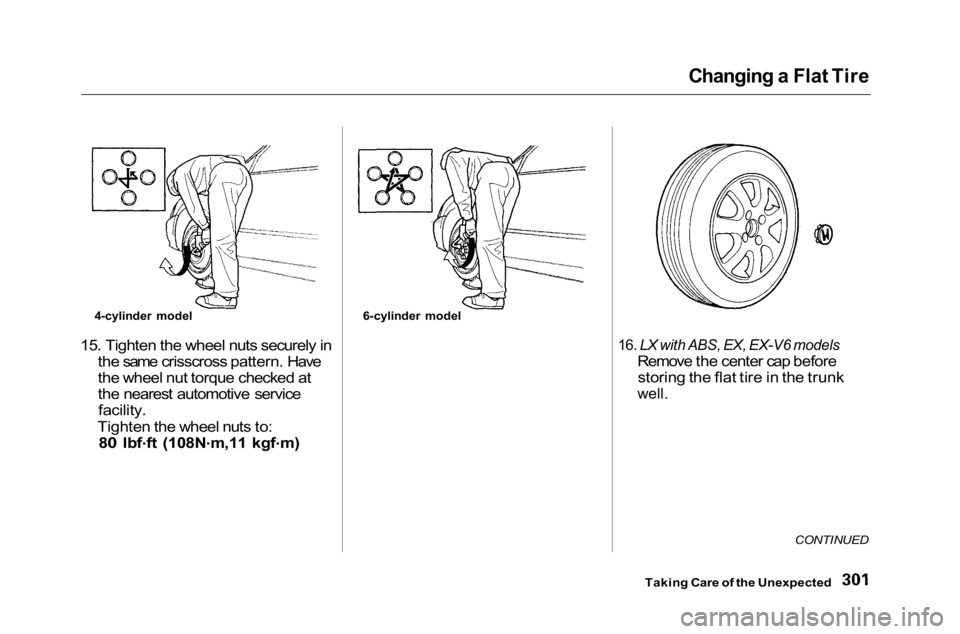
Changing a Flat Tire
15. Tighten the wheel nuts securely in the same crisscross pattern. Have
the wheel nut torque checked at
the nearest automotive service
facility.
Tighten the wheel nuts to:
80 lbf .
ft (108N .
m,11 kgf .
m)
16. LX with ABS, EX, EX-V6 models
Remove the center cap beforestoring the flat tire in the trunk
well.
CONTINUED
Taking Care of the Unexpected
4-cylinder model
6-cylinder model
Page 305 of 372
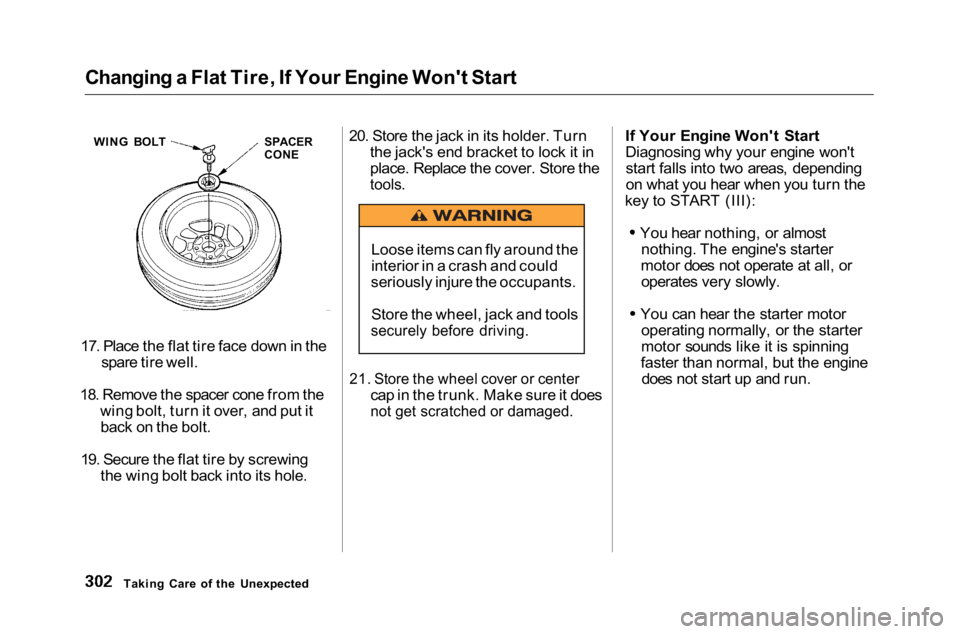
Changing a Flat Tire, If Your Engine Won't Start
17. Place the flat tire face down in the spare tire well.
18. Remove the spacer cone from the wing bolt, turn it over, and put itback on the bolt.
19. Secure the flat tire by screwing the wing bolt back into its hole. 20. Store the jack in its holder. Turn
the jack's end bracket to lock it in
place. Replace the cover. Store the
tools.
21. Store the wheel cover or center
cap in the trunk. Make sure it does
not get scratched or damaged.
If Your Engine Won't Start
Diagnosing why your engine won't
start falls into two areas, depending
on what you hear when you turn the
key to START (III):
You hear nothing, or almostnothing. The engine's starter
motor does not operate at all, or operates very slowly.
You can hear the starter motor operating normally, or the starter
motor sounds like it is spinning
faster than normal, but the engine does not start up and run.
Taking Care of the Unexpected Loose items can fly around the
interior in a crash and could
seriously injure the occupants.
Store the wheel, jack and tools
securely before driving.
WING BOLT
SPACER
CONE
Page 306 of 372
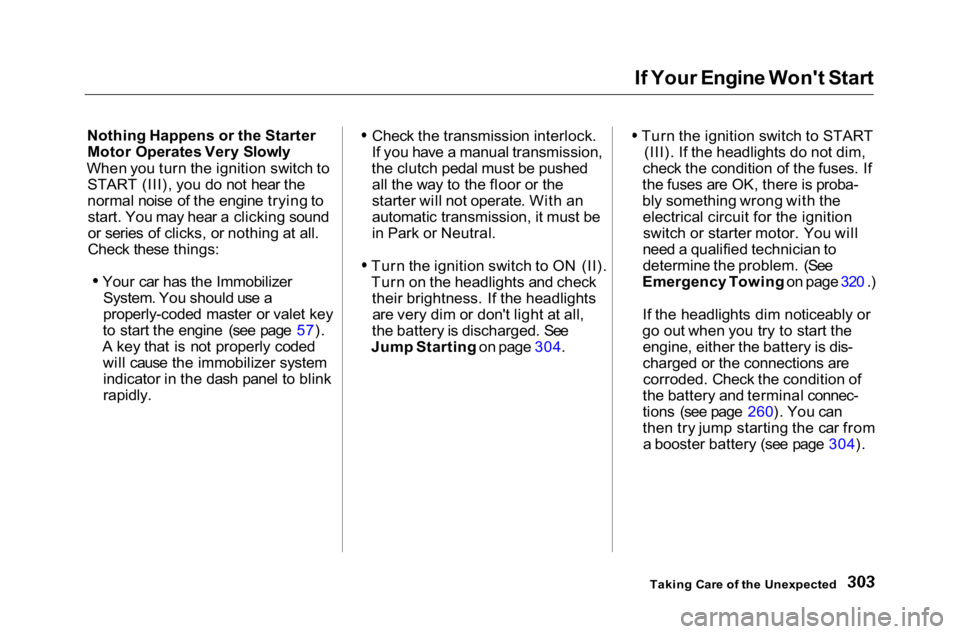
If Your Engine Won't Start
Nothing Happens or the Starter Motor Operates Very Slowly
When you turn the ignition switch to START (III), you do not hear the
normal noise of the engine trying tostart. You may hear a clicking sound
or series of clicks, or nothing at all.
Check these things:
Your car has the ImmobilizerSystem. You should use a
properly-coded master or valet key
to start the engine (see page 57).
A key that is not properly coded will cause the immobilizer systemindicator in the dash panel to blink
rapidly. Check the transmission interlock.
If you have a manual transmission,
the clutch pedal must be pushed all the way to the floor or the
starter will not operate. With an
automatic transmission, it must be
in Park or Neutral.
Turn the ignition switch to ON (II).
Turn on the headlights and check their brightness. If the headlightsare very dim or don't light at all,
the battery is discharged. See
Jump Starting on page 304. Turn the ignition switch to START
(III). If the headlights do not dim,
check the condition of the fuses. If
the fuses are OK, there is proba-
bly something wrong with the electrical circuit for the ignitionswitch or starter motor. You will
need a qualified technician to
determine the problem. (See
Emergency Towing on page 320 .)
If the headlights dim noticeably or
go out when you try to start the engine, either the battery is dis-
charged or the connections arecorroded. Check the condition of
the battery and terminal connec-
tions (see page 260). You can
then try jump starting the car from a booster battery (see page 304).
Taking Care of the Unexpected
Page 307 of 372
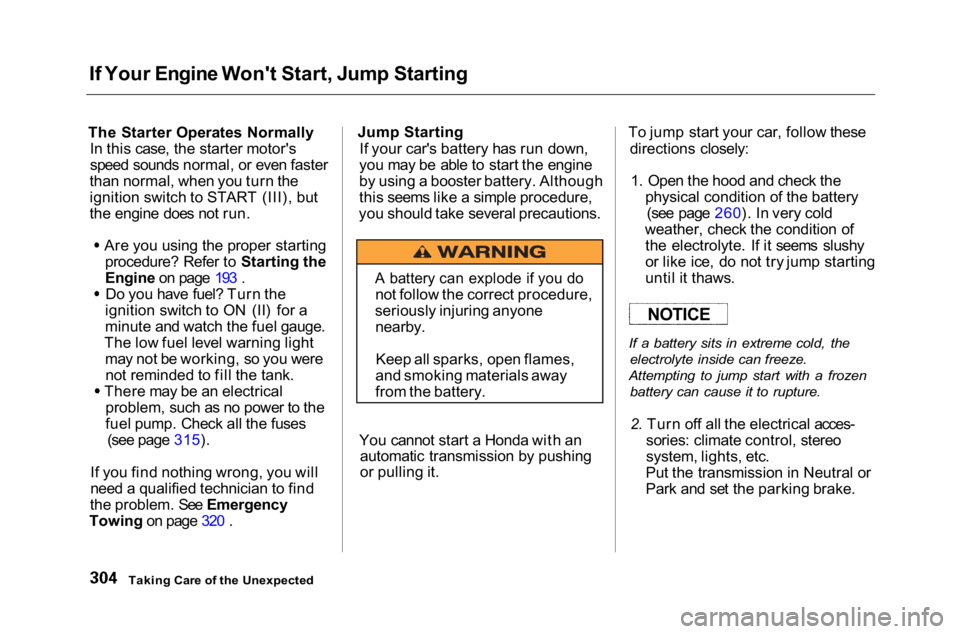
If Your Engine Won't Start, Jump Starting
The Starter Operates Normally In this case, the starter motor's
speed sounds normal, or even faster
than normal, when you turn the
ignition switch to START (III), but
the engine does not run.
Are you using the proper startingprocedure? Refer to Starting the
Engine on page 193 .Do you have fuel? Turn the
ignition switch to ON (II) for a
minute and watch the fuel gauge.
The low fuel level warning light may not be working, so you werenot reminded to fill the tank.
There may be an electrical problem, such as no power to the
fuel pump. Check all the fuses (see page 315).
If you find nothing wrong, you will
need a qualified technician to find
the problem. See Emergency
Towing on page 320 . Jump Starting
If your car's battery has run down,
you may be able to start the engine
by using a booster battery. Although
this seems like a simple procedure,
you should take several precautions.
You cannot start a Honda with an automatic transmission by pushing
or pulling it. To jump start your car, follow these
directions closely:
1. Open the hood and check the physical condition of the battery(see page 260). In very cold
weather, check the condition of the electrolyte. If it seems slushy
or like ice, do not try jump starting
until it thaws.
If a battery sits in extreme cold, the electrolyte inside can freeze.
Attempting to jump start with a frozen battery can cause it to rupture.
2. Turn off all the electrical acces- sories: climate control, stereo
system, lights, etc.
Put the transmission in Neutral or
Park and set the parking brake.
Taking Care of the Unexpected
A battery can explode if you do
not follow the correct procedure,
seriously injuring anyone nearby.
Keep all sparks, open flames,
and smoking materials away
from the battery.
NOTICE
Page 308 of 372
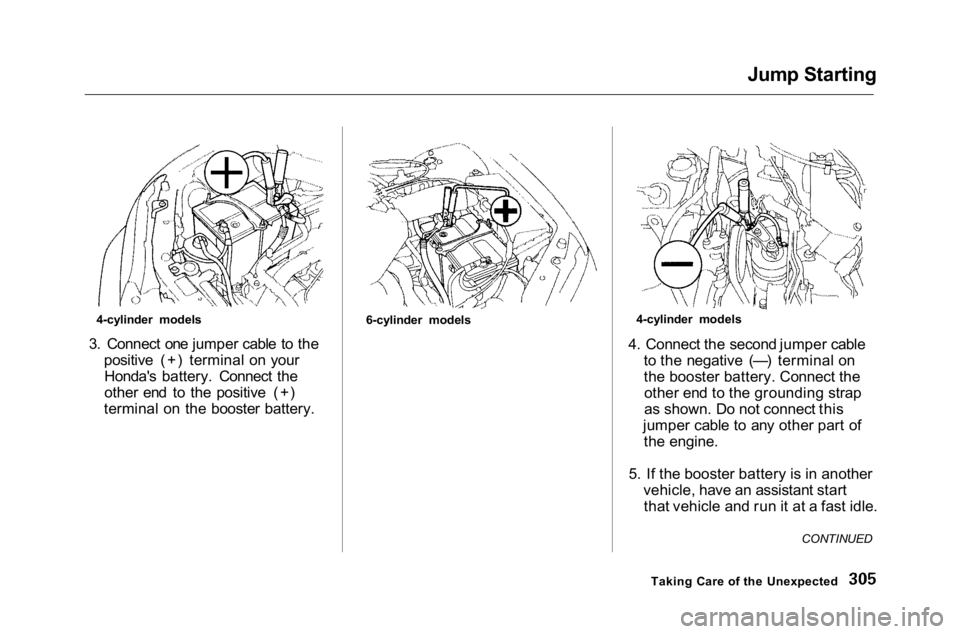
Jump Starting
3. Connect one jumper cable to the positive (+) terminal on yourHonda's battery. Connect the
other end to the positive (+)
terminal on the booster battery. 4. Connect the second jumper cable
to the negative (—) terminal on
the booster battery. Connect theother end to the grounding strap
as shown. Do not connect this
jumper cable to any other part of the engine.
5. If the booster battery is in another vehicle, have an assistant startthat vehicle and run it at a fast idle.
Taking Care of the Unexpected CONTINUED
4-cylinder models
6-cylinder models 4-cylinder models
Page 309 of 372
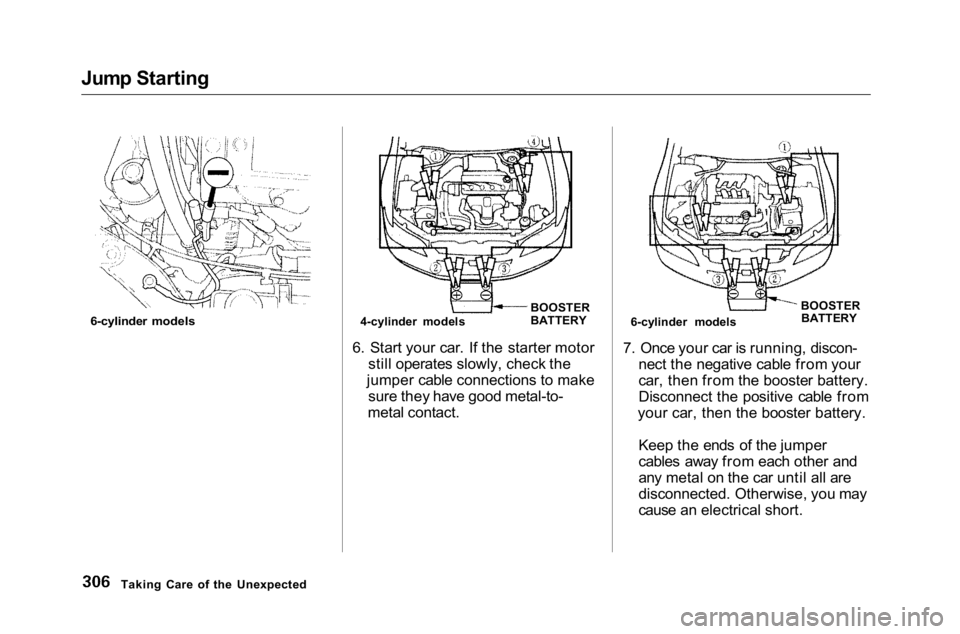
Jump Starting
6. Start your car. If the starter motorstill operates slowly, check the
jumper cable connections to make sure they have good metal-to-
metal contact. 7. Once your car is running, discon-
nect the negative cable from your
car, then from the booster battery.
Disconnect the positive cable from
your car, then the booster battery.
Keep the ends of the jumper
cables away from each other and
any metal on the car until all are
disconnected. Otherwise, you may
cause an electrical short.
Taking Care of the Unexpected
6-cylinder models
4-cylinder modelsBOOSTER
BATTERY
6-cylinder models BOOSTER
BATTERY
Page 310 of 372
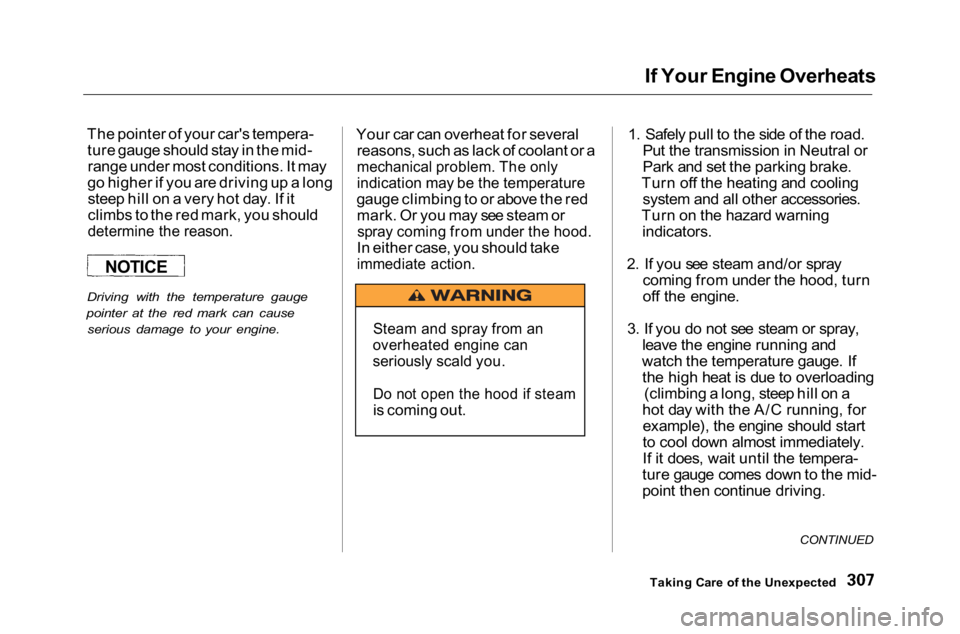
If Your Engine Overheats
The pointer of your car's tempera- ture gauge should stay in the mid-range under most conditions. It may
go higher if you are driving up a long steep hill on a very hot day. If it
climbs to the red mark, you should
determine the reason.
Driving with the temperature gauge
pointer at the red mark can cause serious damage to your engine.
Your car can overheat for several
reasons, such as lack of coolant or a
mechanical problem. The only
indication may be the temperature
gauge climbing to or above the red mark. Or you may see steam or
spray coming from under the hood.
In either case, you should take
immediate action.
1. Safely pull to the side of the road.
Put the transmission in Neutral or
Park and set the parking brake.
Turn off the heating and cooling system and all other accessories.
Turn on the hazard warning indicators.
2. If you see steam and/or spray coming from under the hood, turn
off the engine.
3. If you do not see steam or spray, leave the engine running and
watch the temperature gauge. If the high heat is due to overloading (climbing a long, steep hill on a
hot day with the A/C running, for example), the engine should start
to cool down almost immediately.
If it does, wait until the tempera-
ture gauge comes down to the mid-
point then continue driving.
CONTINUED
Taking Care of the Unexpected
Steam and spray from an
overheated engine can
seriously scald you.
Do not open the hood if steam
is coming out.
NOTICE